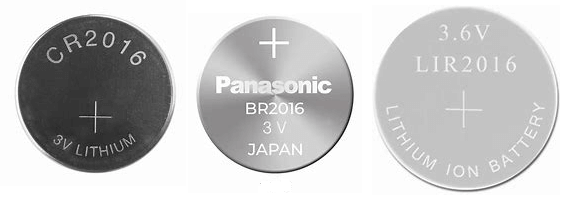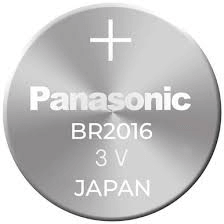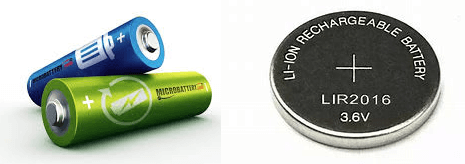A Detailed Guide to CR2016, BR2016, LiR2016, and Their Battery Equivalents
Choosing the right battery is very important today to get the best performance, save money, and help the environment. Small coin cell batteries like the CR2016, BR2016, and LiR2016 show how far we've come in storing energy in tiny packages. This article looks closely at these three types of batteries, explaining their design, what they're made of, how well they work, and which devices they're best for. To find out batteries best for today's electronics, it also looks at how much each one costs and how they affect the environment.
Catalog

Figure 1: CR2016, BR2016 and LiR2016 Battery
What Are CR2016 Batteries?
The CR2016 is a type of coin cell battery, known for its slim and round shape. This lithium coin battery is made from lithium manganese dioxide and resembles a small coin. The "CR" denotes its lithium chemistry while the numbers indicate its dimensions: 20 mm in diameter and 1.6 mm in height. It also weighs around 1.8 grams.
The CR2016's compact size and thin profile make it ideal for devices that need small or slim batteries. Its stainless steel casing prevents corrosion and enhancing its durability and extending its shelf life.
The CR2016 battery has the following performance characteristics:
• Voltage: 3 volts. This provides a stable voltage throughout its life.
• Capacity: About 90 milliampere-hours (mAh), though this can vary by manufacturer and usage conditions.
• Lifespan: The lifespan varies based on the device and usage. In low-drain devices like watches or CMOS batteries on motherboards, it can last several years, often up to 5 years or more. In high-drain devices like electronic car keys, the lifespan is shorter.

Figure 2: CR2016 Battery
Applications and Devices That Use CR2016 Batteries
Watches: Particularly in slim wristwatches.
Calculators: Small and portable models.
Electronic Car Keys: Used for keyless entry systems.
Medical Devices: Glucometers and digital thermometers.
Fitness Devices: Found in wearable tech like heart rate monitors and pedometers.
Computer Motherboards: As a backup power source for the Real-Time Clock (RTC) and CMOS memory.
These batteries are preferred in devices requiring a long-lasting, dependable power source but not high power output and perfect for low-drain applications.
What Are BR2016 Batteries?
The BR2016 battery is a coin cell or button battery, known for its flat circular shape. Measuring about 20 millimeters in diameter and 1.6 millimeters in thickness, it is compact and easy to fit into small devices. The stainless steel casing resists corrosion and enhances durability best for applications that require minimal space and weight.
The BR2016 battery has the following performance characteristics:
• Voltage: BR2016 batteries provide a nominal voltage of around 2.8 volts.
• Capacity: With a capacity ranging from 25 to 30 milliampere-hours (mAh), these batteries hold a sufficient charge to power devices effectively.
• Lifespan: BR2016 battery can last from 2 to 5 years but depending on the device and usage.

Figure 3: BR2016 Battery
Advantages of Using BR2016 Batteries
Small Size: Their compact shape allows devices to be more streamlined and portable.
High Voltage: These batteries provide a steady 3 volts, so they can power devices more efficiently and effectively.
Long Shelf Life: Made with lithium, BR2016 batteries last a long time in storage without losing much power and don't need batteries often or as spare batteries.
Wide Temperature Range: BR2016 batteries work well in extreme temperatures, from -30°C to +85°C. This makes them reliable in both very cold and very hot conditions.
Leak Resistance: These batteries are built to prevent leaks, protecting devices from damage caused by battery acid and improves the lifespan and reliability of the gadgets they power.
Disadvantages of Using BR2016 Batteries
Limited Capacity: BR2016 batteries don't hold a lot of power because of their small size. This can be a problem for devices that use a lot of energy or need to run for a long time.
Higher Cost: BR2016 batteries are more expensive than other similar batteries like the CR2016.
Availability: These batteries are not as commonly found as some other types and hard to find replacements like in remote areas or emergencies.
Environmental Concerns: Like all lithium batteries, BR2016 batteries can be harmful to the environment if not disposed of properly. They contain metals and chemicals that need careful handling to avoid environmental damage.
What Are LiR2016 Batteries?
LiR2016 batteries are lithium-ion coin cells. These batteries are round and flat similar to a coin. The "2016" in their name refers to their size: 20 mm in diameter and 1.6 mm thick. They are small, lightweight, and easy to install in tight spaces. The casing is made of stainless steel that can resists corrosion and enhances durability.
The LiR2016 battery has the following performance characteristics:
• Voltage: LiR2016 batteries have a nominal voltage of 3.6 volts suitable for high-drain devices compared to traditional alkaline batteries.
• Capacity: These batteries offer a capacity of 15 to 30 milliamp-hours (mAh) depending on the manufacturer and specific chemistry.
• Lifespan: The lifespan of LiR2016 batteries varies based on the device and usage. Under normal conditions they can last from several months to a few years.

Figure 4: LiR2016 Battery
Differences Between LiR2016 and Non-Rechargeable Batteries
The LiR2016 battery can be charged many times, so it lasts longer. It holds more energy for its size compared to many single-use batteries. Non-rechargeable batteries, like the CR2016 are used once and then thrown away. These usually hold less energy and can't be recharged.
The LiR2016 gives about 3.6 volts and good for devices that need more power. Non-rechargeable batteries provide a steady 3 volts, works well for devices that don't use much power and need a stable supply over a long time.
At first, LiR2016 batteries cost more because of the advanced technology but since they can be recharged, you buy fewer of them over time, saving money. Non-rechargeable batteries are cheaper upfront but can cost more in the long run if you use them often and have to keep buying new ones.

Figure 5: LiR2016 vs Non-Rechargeable Batteries
Comparative Analysis for CR2016 vs BR2016 vs LiR2016
|
Feature |
CR2016 |
BR2016 |
LiR2016 |
|
Size |
20 mm wide 1.6 mm thick |
20 mm wide 1.6 mm thick |
20 mm wide 1.6 mm thick |
|
Shape |
Coin-like |
Coin-like |
Coin-like |
|
Chemistry |
Lithium manganese dioxide |
Lithium carbon monofluoride |
Lithium-ion |
|
Voltage |
3.0 volts |
3.0 volts |
3.6 volts |
|
Capacity |
90 mAh |
75-90 mAh |
15-30 mAh |
|
Discharge Characteristics |
• Works well in different temperatures • Keeps a steady voltage until almost empty • Good for low power use and high burst power needs |
• Low self-discharge rate • Steady voltage close to 3 volts until almost empty |
• Stable discharge rate • Efficiency drops in colder temperatures and depending on load |
Equivalents for CR2016, BR2016, and LiR2016
|
Original Battery |
Equivalent Batteries |
Type |
|
CR2016 |
DL2016 E-CR2016 5000LC SB-T11 |
Lithium
coin cell |
|
BR2016 |
CR2016 DL2016 |
Lithium
coin cell |
|
LiR2016 |
ML2016 VL2016 CR2016 |
Rechargeable
lithium |
How to Safely Replace a Battery in Your Device?

Figure 6: Replacing a Battery
Step 1: Identify the Part to Replace
Figure out which part needs replacing. Is it broken, outdated, or are you just upgrading? Know what this part does in your device. This will help you understand the impact of replacing it.
Step 2: Choose the Right Replacement
Make sure the new part fits your device in size, power needs, and connections.
Look at the device’s manual or the manufacturer’s website for recommended parts.
Pick components from trusted brands to avoid future problems.
Step 3: Gather Tools and Prepare
Get all required tools like screwdrivers, pliers, and maybe an anti-static wristband.
Set up a clean, organized, and static-free area for the task.
Step 4: Do the Replacement
Turn off the device completely and unplug it from any power sources.
Open the device slowly and keep track of all screws and parts you remove.
Take out the old part and securely install the new one.
Put the device back together in the reverse order you disassembled it.
Step 5: Test Your Device
Turn the device back on to check if it works.
Use diagnostic tools to ensure the new part functions correctly.
Keep an eye on the device for a few days to make sure everything runs smoothly.
Step 6: Document the Replacement
Note the part number, supplier, and date of replacement.
If you keep a log or inventory, update it with the new part information.
Comparative Analysis of Equivalent Batteries, DL2016 vs E-CR2016 vs ML2016
This analysis compares three equivalent batteries, DL2016, E-CR2016, and ML2016 based on temperature tolerance, voltage, capacity, discharge rates, and lifespan. These batteries serve as alternatives to the CR2016, BR2016, and LiR2016 models.

Figure 7: DL2016 vs ML2016 vs E-CR2016
Temperature Tolerance
DL2016: A lithium manganese dioxide battery, DL2016 operates efficiently from -20°C to 70°C.
E-CR2016: This battery also uses lithium manganese dioxide, with a similar temperature range as DL2016.
ML2016: The ML2016 is a rechargeable lithium manganese dioxide battery. It offers better high-temperature endurance up to 85°C, advantageous for medical devices and fitness trackers exposed to body heat.
Voltage and Capacity
DL2016: This battery provides a nominal voltage of 3 volts and a capacity of 80-90 mAh.
E-CR2016: Similar to DL2016, it provides a nominal voltage of 3 volts with capacities ranging from 85-100 mAh.
ML2016: As a rechargeable option, ML2016 offers the same voltage but usually a lower capacity around 25 mAh, due to its rechargeability.
Discharge Rate
DL2016: Designed for low to moderate discharge rates.
E-CR2016: Similar to DL2016, E-CR2016 supports low discharge applications but is often preferred in higher drain devices due to its higher capacity.
ML2016: The rechargeable nature of ML2016 allows it to handle higher discharge rates, beneficial for devices requiring bursts of power like digital cameras.
Lifespan
DL2016: Offers a stable lifespan lasting 5 to 10 years in low-drain applications due to its excellent leakage resistance.
E-CR2016: Expected to last up to 10 years but depending on the device's energy requirements and usage patterns.
ML2016: Rechargeable batteries like ML2016 have shorter lifespans (around 3-5 years) but can be more cost-effective over time due to their ability to be recharged many times.
Selecting between DL2016, E-CR2016, and ML2016 depends on specific device needs:
For general use in low-drain devices, both DL2016 and E-CR2016 are excellent choices.
For devices in high-temperature environments or requiring frequent charging, ML2016 is preferable.
Battery Maintenance and Safety
Avoid Extreme Temperatures: Lithium batteries function best at room temperature. Exposure to extreme cold or heat can reduce their capacity and lifespan. Keep your devices away from direct sunlight, and avoid leaving them in hot cars or freezing environments.
Maintain Moderate Charge Levels: Regularly charging your lithium batteries to 100% or letting them drop to 0% can be harmful. Aim to keep the charge between 20% and 80%. Once your device is fully charged, unplug it to avoid stressing the battery.
Limit Fast Charging: Fast charging can be convenient but also puts stress on the battery, when it's very low. Use fast charging sparingly and stick to regular charging speeds for better long-term health.
Store Properly: If you're not using a lithium battery for a while, store it in a cool, dry place with about a 50% charge. This helps maintain its health during periods of inactivity.
Use Appropriate Chargers: Always use the charger that came with your device or one certified by the manufacturer. Using incorrect chargers can damage the battery.
Recycle Properly: Do not dispose of lithium batteries in household waste. They contain toxic and recyclable materials. Many electronics stores and local waste facilities offer battery recycling services.
Conclusion
Comparing CR2016, BR2016, and LiR2016 batteries shows that each type is best for different devices and uses. CR2016 batteries are reliable and last long in devices that don't use much power. BR2016 batteries have a bit less voltage and capacity but work well in extreme temperatures and small devices. LiR2016 batteries can be recharged and making them cheaper over time for devices that use a lot of power. Choosing the right battery involves looking at technical details, environmental effects, and costs. Modern technology keeps pushing for better batteries that store more energy, are environmentally friendly, and are safe and easy to use. This article helps explain how to choose and use coin cell batteries in different tech gadgets.
Frequently Asked Questions [FAQ]
1. Can you use a CR2032 battery in place of a CR2016 battery?
No, you should not use a CR2032 battery in place of a CR2016 battery. Both batteries are 20 mm in diameter, but the CR2032 is 3.2 mm thick, whereas the CR2016 is only 1.6 mm thick. This size difference affects how the battery fits into the battery compartment and can lead to issues such as poor contact or inability to close the battery compartment lid. The increased thickness can potentially damage the device's internal components or the battery casing.
2. What's the difference between 2016 and 2025 batteries?
The main difference between a CR2016 and a CR2025 battery is their thickness and their capacity. Both batteries measure 20 mm in diameter. However, the CR2025 is thicker at 2.5 mm compared to the 1.6 mm thickness of the CR2016. This difference in thickness allows the CR2025 to hold more chemical material and thus offer a higher capacity providing longer life for devices that require more power.
3. What is the difference between CR2016 and CR1620?
The main difference between the CR2016 and CR1620 batteries lies in their dimensions and capacity. Both have the same diameter of 20 mm but their thicknesses differ: the CR2016 is 1.6 mm thick, while the CR1620 is 2.0 mm thick. This variation affects their electrical capacity with the CR1620 having a higher capacity than the CR2016, means it can store more energy and last longer in devices.
4. How to stack CR2016 batteries?
Stacking CR2016 batteries involves aligning them in series to increase the voltage. Here’s how to do it:
Ensure polarity alignment: The positive side of one battery should be facing the negative side of the other.
Use conductive material: Place a small piece of conductive material (like foil) between the batteries to ensure a good electrical connection.
Secure the batteries: Use non-conductive tape to hold the batteries together securely, ensuring they do not move or lose contact.
5. How do you test a CR2016 battery?
To test a CR2016 battery, use a digital multimeter:
Set the multimeter: Turn it to the DC voltage setting.
Test the battery: Place the red probe on the positive side of the battery and the black probe on the negative side.
Read the voltage: A fully charged CR2016 should read around 3 volts. Values lower (e.g., below 2.5 volts) indicate the battery is depleted.
6. Do CR2016 batteries leak?
CR2016 batteries can leak under certain conditions such as excessive heat, damage, or after a prolonged period of use. Leaking batteries often show signs of corrosion or a white or greenish powdery substance on the battery terminals. To prevent leakage, store batteries at room temperature, away from direct sunlight, and consider replacing them regularly before they are completely drained.